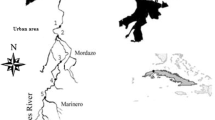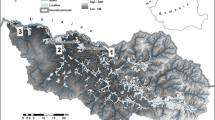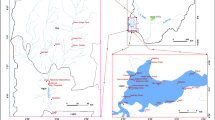Abstract
Purpose
Polycyclic aromatic hydrocarbons (PAHs) are toxic and volatile in nature. They can persist for a long time in the environment. The aim of this work was to investigate the levels of PAHs and their diagnostic ratios in the samples of lake water of Grovnes peninsula, East Antarctica.
Methods
Total fourty five samples were collected from fifteen different lakes of the Northern & Southern Grovnes peninsula. Sixteen compounds of PAHs were estimated in the samples by GC–MS/MS (Gas chromatography-mass spectrometry) technique.
Results
PAHs levels were found from 10.33 to 44.35 pg ml−1 in the lake water samples. Fluorene was detected in all fifteen different lakes. The highest concentration of fluorene was found in the L7BNG lake. PAHs diagnostic ratios were found in the range of 0.76–4.68 for ∑LMW/∑HMW, 0.44–0.80 for FL/(FL + PYR), 1.00 for ANT/(ANT + PHE), 0.37–0.58 for FLA/(FLA + PYR), 0.44–0.47 for BaA/(BaA + CHR) in all fifteen different lakes.
Conclusion
The present study confirms the presence of PAHs in a small amount in Grovnes peninsula, East Antarctica. The presence of additional pollutants should be investigated in order to comprehensively assess the scale of environmental pollution in Antarctica.





Similar content being viewed by others
Data availability
Not applicable.
Code availability
Not applicable.
References
Bharti PK, Niyogi UK (2015) Assessment of Pollution in a freshwater lake at Fisher Island, Larsemann Hills over east Antarctica. Science International 3(1):25–30
Gillieson D (1990) An atlas of the lakes of the Larsemann Hills, Princess Elizabeth Land, Antarctica (Vol. 74). Australian National Antarctic Research Expeditions, Antarctic Division, Dept. of the Arts, Sport, the Environment, Tourism, and Territories.
Roberts D, McMinn A (1996) Relationships between surface sediment diatom assemblages and water chemistry grdients in saline lakes of the Vestfold Hills. Antarctica Antarctic Science 8(4):331–341
Hodgson DA, Vyverman W, Sabbe K (2001) Limnology and biology of saline lakes in the Rauer Islands, eastrn Antarctica. Antarct Sci 13(3):255
Legrand M, Mayewski P (1997) Glaciochemistry of polar ice cores: a review. Rev Geophys 5(3):219–243
Avino P, Notardonato I, Perugini L, Russo MV (2017) New protocol based on high-volume sampling followed by DLLME-GC-IT/MS for determining PAHs at ultra-trace levels in surface water samples. Mirochemical Journal 133:251–257
Wild S, McLagan D, Schlabach M, Bossi R, Hawker D, Cropp R, King CK, Stark JS, Mondon J, Nash SB (2015) An Antarctic research station as a source of brominated and perfluorinated persistent organic pollutants to the local environment. Environ Sci Technol 49(1):103–112
Hund AJ (2014) Antarctica and the Arctic Circle: A Geographic Encyclopedia of the Earth's Polar Regions [2 volumes]. ABC-CLIO.
Fuoco R, Giannarelli S, Wei Y, Ceccarini A, Abete C, Francesconi S, Termine M (2009) Persistent organic pollutants (POPs) at Ross sea (Antarctica). Microchem J 92(1):44–48
Barrie LA, Gregor D, Hargrave B, Lake R, Muir D, Shearer R, Tracey B, Bidleman T (1992) Arctic contaminant: sources, occurrence and pathways. Sci Total Environ 122(1–2):1–74
Negoita TG, Covaci A, Gheorghe A, Schepens P (2003) Distribution of polychlorinated biphenyls (PCBs) an organochlorine pesticides in soils from the East Antarctic coast. J Environ Monit 5(2):281–286
Jacob J (2013) A review of the accumulation and distribution of persistent organic pollutants in the environment. Int J Biosci Biochem Bioinform 3(6):657
UNEP (United Nations Environmental Programme) (1992) Determination of petroleum hydrocarbons in sediments, reference methods for marine pollution studies. UNEP, Nairobi, Kenya 20:97
Yang Z, Feng J, Niu J, Shen Z (2008) Release of polycyclic aromatic hydrocarbons from Yangtze River sedient cores during periods of simulated resuspension. Environ Pollut 155(2):366–374
Woolfenden EN, Hince G, Powell SM, Stark SC, Snape I, Stark JS, George SC (2011) The rate of removal ad the compositional changes of diesel in Antarctic marine sediment. Sci Total Environ 410:205–216
Kennicutt MC, Sweet ST, Fraser WR, Stockton WL, Culver M (1991) Grounding of the Bahia Paraiso a Arthur Harbor, Antarctica. 1. Distribution and fate of oil spill related hydrocarbons. Environ Sci Technol 25(3):509–518.
Priddle J (2002) Regionally based assessment of persistent toxic substances-Antarctica. United Nations Environment Program Global Environment Facility. Chatelaine, Switzerland: UNEP Chemicals
Dauner ALL, Hernández EA, MacCormack WP, Martins CC (2015) Molecular characterisation of anthropogenic sources of sedimentary organic matter from Potter Cove, King George Island, Antarctica. Sci Total Environ 502:408–416
Moodley L, Arnberg M, Dunaevskaya E, Seear P, Bærheim L, Nilsen M, Ramanand SS, Øysæd KB, Westerlund S, Jonsson G, Tarling GA (2018) Effects of low crude oil chronic exposure on the northern krill (Meganyctiphanes norvegica). J Exp Mar Biol Ecol 500:120–131
Cripps GC (1992) Natural and anthropogenic hydrocarbons in the Antarctic marine environment. Mar Pollut Bull 25(9–12):266–273
Dobbins RA, Fletcher RA, Benner JBA, Hoeft S (2006) Polycyclic aromatic hydrocarbons in flames, in diesel fuels, and in diesel emissions. Combust Flame 144(4):773–781
Liang F, Lu M, Keener TC, Liu Z, Khang SJ (2005) The organic composition of diesel particulate matter, diesel fuel and engine oil of a non-road diesel generator. J Environ Monit 7(10):983–988
Yang R, Xie T, Li A, Yang H, Turner S, Wu G, Jing C (2016) Sedimentary records of polycyclic aromatic hydrocarbons (PAHs) in remote lakes across the Tibetan Plateau. Environ Pollut 214:1–7
Liu B, Xue Z, Zhu X, Jia C (2017) Long-term trends (1990–2014), health risks, and sources of atmospheric polycyclic aromatic hydrocarbons (PAHs) in the US. Environ Pollut 220:1171–1179
Cabrerizo A, Dachs J, Barceló D, Jones KC (2012) Influence of organic matter content and human activities on the occurrence of organic pollutants in Antarctic soils, lichens, grass, and mosses. Environ Sci Technol 46(3):1396–1405
Piazza R, Gambaro A, Argiriadis E, Vecchiato M, Zambon S, Cescon P, Barbante C (2013) Development of a method for simultaneous analysis of PCDDs, PCDFs, PCBs, PBDEs, PCNs and PAHs in Antarctic air. Anal Bioanal Chem 405(2–3):917–932
Bhardwaj LK, Chauhan A, Ranjan A, Jindal T (2018) Persistent organic pollutants in biotic and abiotic components of Antarctic pristine environment. Earth Systems and Environment 2(1):35–54
Ravindra K, Sokhi R, Van Grieken R (2008) Atmospheric polycyclic aromatic hydrocarbons: source attribution, emission factors and regulation. Atmos Environ 42(13):2895–2921
Yunker MB, Macdonald RW, Vingarzan R, Mitchell RH, Goyette D, Sylvestre S (2002) PAHs in the Fraser River basin: a critical appraisal of PAH ratios as indicators of PAH source and composition. Org Geochem 33(4):489–515
Mackay D, Shiu WY, Lee SC (2006) Handbook of physical-chemical properties and environmental fate for organic chemicals. CRC Press
Manoli E, Kouras A, Samara C (2004) Profile analysis of ambient and source emitted particle-bound polycyclic aromatic hydrocarbons from three sites in northern Greece. Chemosphere 56(9):867–878
Mostert MM, Ayoko GA, Kokot S (2010) Application of chemometrics to analysis of soil pollutants. TrAC, Trends Anal Chem 29(5):430–445
Sun F, Wen D, Kuang Y, Li J, Li J, Zuo W (2010). Concentrations of heavy metals and polycyclic aromatic hydrocarbons in needles of Masson pine (Pinus massoniana L.) growing nearby different industrial sources. J Environ Sci 22(7):1006–1013.
Hodgson DA, Verleyen E, Sabbe K, Squier AH, Keely BJ, Leng MJ, Saunders KM, Vyverman W (2005) Late Quaternary climate-driven environmental change in the Larsemann Hills, East Antarctica, multi-proxy evidence from a lake sediment core. Quatern Res 64(1):83–99
USEPA (2007) Method 1699: Pesticides in Water, Soil, Sediment, Biosolids and Tissue by HRGC/HRMS.
USEPA 3510B (1994) Separatory Funnel Liquid Liquid Extraction. Revision 2, September 1994.
USEPA 3630C (1996) Silica Gel Cleanup. Revision 3, December 1996.
Bhardwaj LK, Sharma S, Ranjan A, Jindal T (2019) Persistent organic pollutants in lakes of Broknes peninsula at Larsemann Hills area. East Antarctica Ecotoxicology 28(5):589–596
Lenihan HS, Oliver JS, Oakden JM, Stephenson MD (1990) Intense and localized benthic marine pollution around McMurdo Station. Antarctica Marine Pollution Bulletin 21(9):422–430
Wania F, Mackay D (1996) Peer reviewed: tracking the distribution of persistent organic pollutants. Environ Sci Technol 30(9):390A-396A
Hale RC, Kim LS, Harvey E, Guadia MJL, Mainor TM, Bush E, Jacobs EM (2008) Antarctic research bases: local sources of polybrominated diphenyl ether (PBDE) flame retardants. Environ Sci Technol 42:1452–1457
Ravindra K, Wauters E, Van Grieken R (2008) Variation in particulate PAHs levels and their relation with the transboundary movement of the air masses. Sci Total Environ 396(2–3):100–110
Miguel AH, Kirchstetter TW, Harley RB, Hering RA (1998) On-road emissions of particulate polycyclic aromatichydrocarbons and black carbon from gasoline and dieselvehicles. Environ Sci Technol 32:450–455
Tao S, Li X, Yang Y, Coveney RM, Lu X, Chen H, Shen W (2006) Dispersion modeling of polycyclic aromatic hydrocarbons from combustion of biomass and fossil fuels and production of coke in Tianjin. China Environmental science & technology 40(15):4586–4591
Dickhut RM, Cincinelli A, Cochran M, Ducklow HW (2005) Atmospheric concentrations and air-water flux of organochlorine pesticides along the western Antarctic Peninsula. Environ Sci Technol 39:465–470
Fuoco R, Giannarelli S, Wei Y, Abete C, Francesconi S, Termine M (2005) Polychlorobiphenyls and polycyclic aromatic hydrocarbons in the sea-surface micro-layer and the water column at Gerlache Inlet, Antarctica. J Environ Monitoring 7:1313–1319
Kim M, Kennicutt MC, Qian Y (2006) Molecular and stable carbon isotopic characterization of PAH contaminants at McMurdo Station, Antarctica. Mar Pollut Bull 52:1585–1590
Curtosi A, Pelletier E, Vodopivez CL, Mac Cormack WP (2007) Polycyclic aromatic hydrocarbons in soil and surface marine sediment near Jubany Station (Antarctica). Role of permafrost as a low-permeability barrier. Sci Total Environ 383:193–204
Klanova J, Matykiewiczova N, Macka Z, Prosek P, Laska K, Klan P (2008) Persistent organic pollutants in soils and sediments from James ROSS Island, Antarctica. Environ Pollut 152:416–423
Deelaman W, Pongpiachan S, Tipmanee D, Suttinun O, Choochuay C, Iadtem N, Charoenkalunyuta T, Promdee K (2020) Source apportionment of polycyclic aromatic hydrocarbons in the terrestrial soils of King George Island, Antarctica. J South Am Earth Sci 104:102832.
Alekseev I, Abakumov E (2021) Polycyclic aromatic hydrocarbons, mercury and arsenic content in soils of larsemann hills, pravda coast and fulmar island, eastern antarctica. Bull Environ Contam Toxicol 106(2):278–288
Paruk JD, Long D IV, Perkins C, East A, Sigel BJ, Evers DC (2014) Polycyclic aromatic hydrocarbons detected in Common Loons (Gavia immer) wintering off coastal Louisiana. Waterbirds 37:85–93
Goldsworthy PM, Canning EA, Riddle MJ (2003) Soil and water contamination in the Larsemann Hills. East Antarctica Polar Record 39(4):319–337
Yao Y, Meng XZ, Wu CC, Bao LJ, Wang F, Wu FC, Zeng EY (2016) Tracking human footprints in Antarctica through passive sampling of polycyclic aromatic hydrocarbons in inland lakes. Environ Pollut 213:412–419
Young LY, Cerniglia CE (1995) Microbial transformation and degradation of toxic organic chemicals, vol 15. Wiley-Liss, New York
Na G, Gao Y, Li R, Gao H, Hou C, Ye J, Jin S, Zhang Z (2020) Occurrence and sources of polycyclic aromatic hydrocarbons in atmosphere and soil from 2013 to 2019 in the Fildes Peninsula, Antarctica. Marine Pollution Bulletin 156:111173.
Gran-Scheuch A, Ramos-Zuñiga J, Fuentes E, Bravo D, Pérez-Donoso JM (2020) Effect of Co-contamination by PAHs and heavy metals on bacterial communities of diesel contaminated soils of South Shetland Islands. Antarctica Microorganisms 8(11):1749
Préndez M, Barra C, Toledo C, Richter P (2011) Alkanes and polycyclic aromatic hydrocarbons in marine surficial sediment near Antarctic stations at Fildes Peninsula. King George Island Antarctic Sci 23(6):578
Szopińska M, Namieśnik J, Polkowska Ż (2016) How important is research on pollution levels in Antarctica? Historical approach, difficulties and current trends. In Reviews of Environmental Contamination and Toxicology 239:79–156. Springer, Cham.
Corsolini S, Borghesi N, Ademollo N, Focardi S (2011) Chlorinated biphenyls and pesticides in migrating and resident seabirds from East and West Antarctica. Environ Int 37(8):1329–1335
Kumar KS, Kannan K, Corsolini S, Evans T, Giesy JP, Nakanishi J, Masunaga S (2002) Polychlorinated dibenzo-p-dioxins, dibenzofurans and polychlorinated biphenyls in polar bear, penguin and south polar skua. Environ Pollut 119(2):151–161
Szopińska M, Szumińska D, Bialik RJ, Dymerski T, Rosenberg E, Polkowska Ż (2019) Determination of polycyclic aromatic hydrocarbons (PAHs) and other organic pollutants in freshwaters on the western shore of Admiralty Bay (King George Island, Maritime Antarctica). Environ Sci Pollut Res 26(18):18143–18161
Wang L, Yang Z, Niu J, Wang J (2009) Characterization, ecological risk assessment and source diagnostics of polycyclic aromatic hydrocarbons in water column of the Yellow River Delta, one of the most plenty biodiversity zones in the world. J Hazard Mater 169(1–3):460–465
Wang JZ, Nie YF, Luo XL, Zeng EY (2008) Occurrence and phase distribution of polycyclic aromatic hydrocarbons in riverine runoff of the Pearl River Delta. China Marine Pollution Bulletin 57(6–12):767–774
Opuene K, Agbozu IE, Adegboro OO (2009) A critical appraisal of PAH indices as indicators of PAH source and composition in Elelenwo Creek, southern Nigeria. Environmentalist 29(1):47–55
Tobiszewski M, Tsakovski S, Simeonov V, Namieśnik J (2010) Surface water quality assessment by the use of combination of multivariate statistical classification and expert information. Chemosphere 80(7):740–746
Riccardi C, Di Filippo P, Pomata D, Incoronato F, Di Basilio M, Papini MP, Spicaglia S (2008) Characterization and distribution of petroleum hydrocarbons and heavy metals in groundwater from three Italian tank farms. Sci Total Environ 393(1):50–63
Wang Y, Li PH, Li HL, Liu XH, Wang WX (2010) PAHs distribution in precipitation at Mount Taishan: China. Identification of sources and meteorological influences. Atmospheric Res 95(1):1–7.
Li PH, Wang Y, Li YH, Wang ZF, Zhang HY, Xu PJ, Wang WX (2010) Characterization of polycyclic aromatic hydrocarbons deposition in PM2. 5 and cloud/fog water at Mount Taishan (China). Atmospheric Environ 44(16):1996–2003.
Hwang HM, Foster GD (2006) Characterization of polycyclic aromatic hydrocarbons in urban stormwater runoff flowing into the tidal Anacostia River, Washington, DC, USA. Environ Pollut 140(3):416–426
Jacobs LE, Weavers LK, Chin YP (2008) Direct and indirect photolysis of polycyclic aromatic hydrocarbons in nitrate-rich surface waters. Environ Toxicol Chem 27(8):1643–1648
Tobiszewski M, Namieśnik J (2012) PAH diagnostic ratios for the identification of pollution emission sources. Environ Pollut 162:110–119
Zhang W, Zhang S, Wan C, Yue D, Ye Y, Wang X (2008) Source diagnostics of polycyclic aromatic hydrocarbons in urban road runoff, dust, rain and canopy throughfall. Environ Pollut 153(3):594–601
Pies C, Hoffmann B, Petrowsky J, Yang Y, Ternes TA, Hofmann T (2008) Characterization and source identification of polycyclic aromatic hydrocarbons (PAHs) in river bank soils. Chemosphere 72(10):1594–1601
Roberto J, Lee WY, Campos-Díaz SI (2009) Soil-borne polycyclic aromatic hydrocarbons in El Paso, Texas: analysis of a potential problem in the United States/Mexico border region. J Hazard Mater 163(2–3):946–958
Akyüz M, Çabuk H (2010) Gas–particle partitioning and seasonal variation of polycyclic aromatic hydrocarbons in the atmosphere of Zonguldak. Turkey Sci Total Environ 408(22):5550–5558
Oliveira C, Martins N, Tavares J, Pio C, Cerqueira M, Matos M, Silva H, Oliveira C, Camões F (2011) Size distribution of polycyclic aromatic hydrocarbons in a roadway tunnel in Lisbon. Portugal Chemosphere 83(11):1588–1596
Boekelheide K, Blumberg B, Chapin RE, Cote I, Graziano JH, Janesick A, Lane R, Lillycrop K, Myatt L, States JC, Thayer KA (2012) Predicting later-life outcomes of early-life exposures. Environ Health Perspect 120(10):1353–1361
Acknowledgements
The authors acknowledge with thanks to the Director of NCPOR (National Centre for Polar and Ocean Research) and Earth Sciences, Ministry for the participation in 34th ISEA.
Funding
This study was not supported by any funding agency.
Author information
Authors and Affiliations
Contributions
All authors have equal contribution.
Corresponding author
Ethics declarations
Conflict of interest
The authors declare that they have no competing interests.
Rights and permissions
About this article
Cite this article
Bhardwaj, L.K., Sharma, S. & Jindal, T. Occurrence of Polycyclic Aromatic Hydrocarbons (PAHs) in the Lake Water at Grovnes Peninsula Over East Antarctica. Chemistry Africa 4, 965–980 (2021). https://doi.org/10.1007/s42250-021-00278-0
Received:
Accepted:
Published:
Issue Date:
DOI: https://doi.org/10.1007/s42250-021-00278-0




